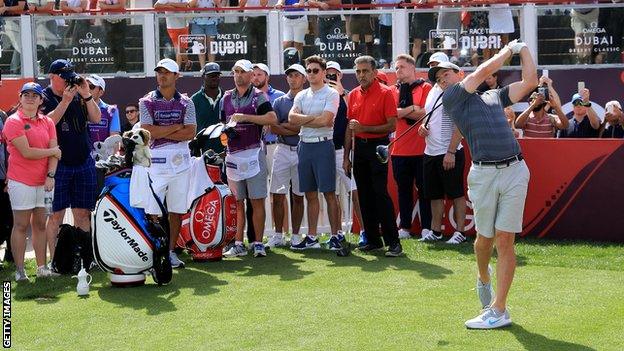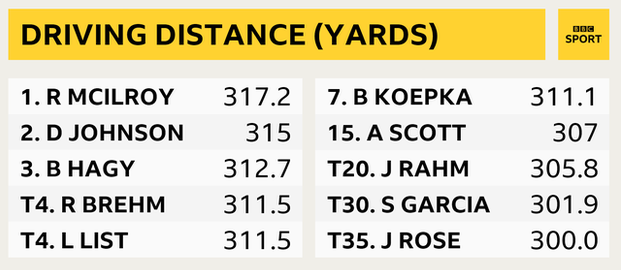Rory McIlroy: No need to "curtail" the increasing distance golf balls can travel
- Published

Rory McIlroy claimed his first professional win aged 19 at the 2009 Dubai Desert Classic
Omega Dubai Desert Classic |
|---|
Venue: Emirates Golf Club. Dates: 15-28 Jan |
Coverage: Score and reports on the BBC Sport website |
Rory McIlroy says he does not see the need to curtail the distance golf balls can travel despite the new generation appearing to add even more length.
Last week Sergio Garcia averaged over 18 yards longer with the new Callaway Chrome Soft Ball than he did in 2017.
The new ball features graphene, which is described as "200 times stronger than steel, but incredibly flexible".
"I don't think the ball travels too far, but I can see the argument," four-time major McIlroy told Radio 5 live.
Last season the Northern Irishman had the longest average driving distance on both the European Tour, at 318.5 yards, and the PGA Tour, at 317.2.
Garcia averaged 301.9 yards on the PGA Tour in 2017, but the Masters champion reached an average of 320 yards en route to winning the Singapore Open by five shots last weekend.

A total of 43 players on the PGA Tour had a driving average distance of more than 300 yards last season
"The only reason I would say the ball travels too far is that it's made some courses obsolete. The longer players will always be long," McIlroy told BBC Radio 5 live's Breakfast programme.
"It's a shame because some of the old courses are the best, with the best architecture."
There have been calls to alter the specification of balls to limit how far they fly - 43 players on the PGA Tour had a driving average distance of more than 300 yards last season.
Last week in Abu Dhabi, world number one Dustin Johnson said there is no need to limit how far golf balls travel because nobody "is making the game too easy".
Johnson hit a 433-yard drive to within six inches of the hole on a par four at the Tournament of Champions in Hawaii earlier this month.

World number one Dustin Johnson averaged 317.3 yards off the tee last week at the Abu Dhabi HSBC Championship
"The headlines are generated by the elite players. Dustin Johnson is an elite athlete. The golf ball has regulations to its performance, but there is still a lot of room for development within the current rules," said Alan Hocknall, senior vice president of research and development at Callaway.
According to the University of Manchester, where graphene was discovered, the material is "ultra-light yet immensely tough".
It is infused into the outer core of the ball and as it is so strong, the outer core can be made thinner.
In turn this allows for a larger inner core, which enhances the ball's speed and also reduces the amount of spin on long shots, leading to greater distance.
Analysis - 'The last thing we need is a golf ball that travels even further'
BBC golf correspondent Iain Carter
Frankly the last thing golf needs is the ball to travel further. Golf courses are too long, it takes too long to play, they are too expensive to maintain.
What golf needs, in my opinion, is to go in the opposite direction. When you go to the driving range and you hit balls there and they don't really fly as far as the ones you use on the golf course, that proves the technology is there to make golf balls that won't travel quite as far.
It is almost the same story with the javelin in athletics. The athletes were throwing it too far, they were endangering runners on the track, so they changed the dynamic of the javelin so it fits in the infield and that's what golf needs to do.